Ziqing Xing
Multi-View Wireless Sensing via Conditional Generative Learning: Framework and Model Design
May 19, 2025Abstract:In this paper, we incorporate physical knowledge into learning-based high-precision target sensing using the multi-view channel state information (CSI) between multiple base stations (BSs) and user equipment (UEs). Such kind of multi-view sensing problem can be naturally cast into a conditional generation framework. To this end, we design a bipartite neural network architecture, the first part of which uses an elaborately designed encoder to fuse the latent target features embedded in the multi-view CSI, and then the second uses them as conditioning inputs of a powerful generative model to guide the target's reconstruction. Specifically, the encoder is designed to capture the physical correlation between the CSI and the target, and also be adaptive to the numbers and positions of BS-UE pairs. Therein the view-specific nature of CSI is assimilated by introducing a spatial positional embedding scheme, which exploits the structure of electromagnetic(EM)-wave propagation channels. Finally, a conditional diffusion model with a weighted loss is employed to generate the target's point cloud from the fused features. Extensive numerical results demonstrate that the proposed generative multi-view (Gen-MV) sensing framework exhibits excellent flexibility and significant performance improvement on the reconstruction quality of target's shape and EM properties.
Analogical Learning for Cross-Scenario Generalization: Framework and Application to Intelligent Localization
Apr 09, 2025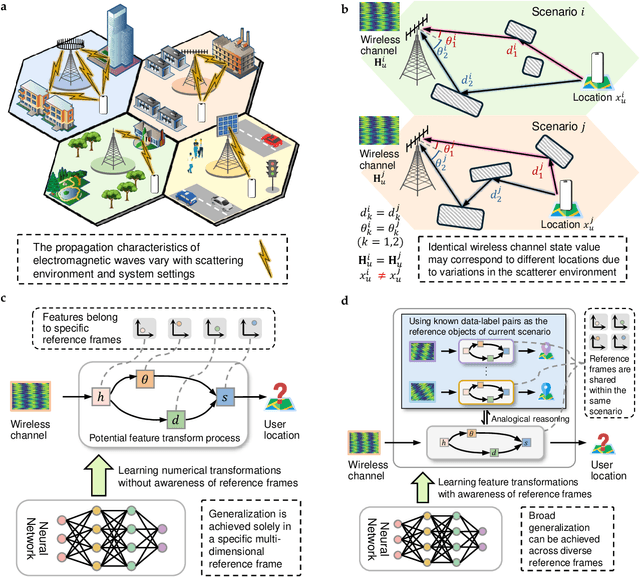
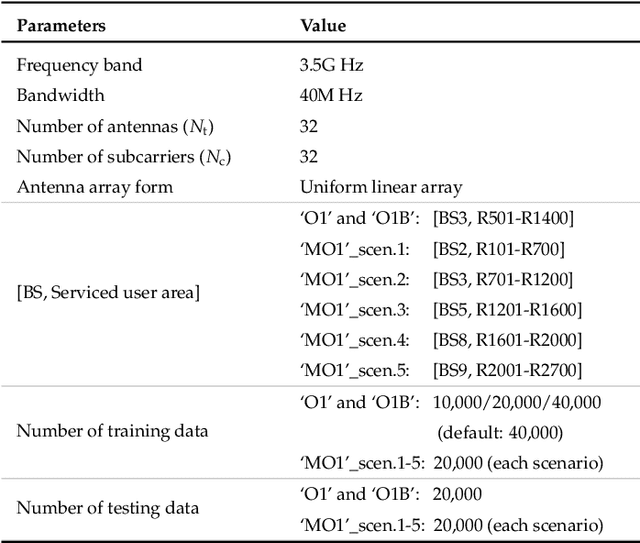
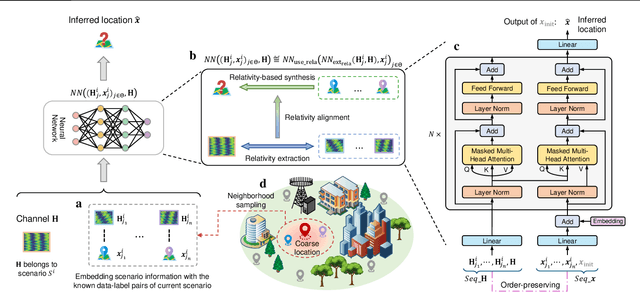
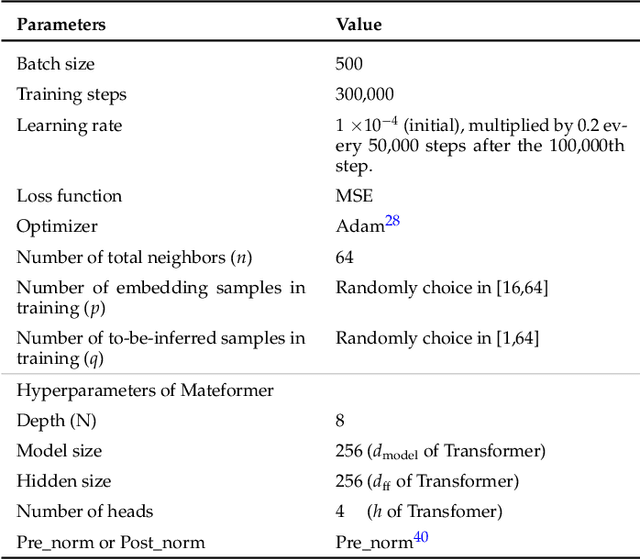
Abstract:Existing learning models often exhibit poor generalization when deployed across diverse scenarios. It is mainly due to that the underlying reference frame of the data varies with the deployment environment and settings. However, despite the data of each scenario has its distinct reference frame, its generation generally follows the same underlying physical rule. Based on these findings, this article proposes a brand-new universal deep learning framework named analogical learning (AL), which provides a highly efficient way to implicitly retrieve the reference frame information associated with a scenario and then to make accurate prediction by relative analogy across scenarios. Specifically, an elegant bipartite neural network architecture called Mateformer is designed, the first part of which calculates the relativity within multiple feature spaces between the input data and a small amount of embedded data from the current scenario, while the second part uses these relativity to guide the nonlinear analogy. We apply AL to the typical multi-scenario learning problem of intelligent wireless localization in cellular networks. Extensive experiments show that AL achieves state-of-the-art accuracy, stable transferability and robust adaptation to new scenarios without any tuning, and outperforming conventional methods with a precision improvement of nearly two orders of magnitude. All data and code are available at https://github.com/ziruichen-research/ALLoc.
Towards Wireless-Native Big AI Model: Insights into Its Ambitions, Peculiarities and Methodologies
Dec 12, 2024Abstract:Researches on leveraging big artificial intelligence model (BAIM) technology to drive the intelligent evolution of wireless networks are emerging. However, since the breakthrough in generalization brought about by BAIM techniques mainly occurs in natural language processing, there is still a lack of a clear technical roadmap on how to efficiently apply BAIM techniques to wireless systems with many additional peculiarities. To this end, this paper first reviews recent research works on BAIM for wireless and assesses the current research situation. Then, this paper analyzes and compares the differences between language intelligence and wireless intelligence on multiple levels, including scientific foundations, core usages, and technical details. It highlights the necessity and scientific significance of developing BAIM technology in a wireless-native way, as well as new issues that need to be considered in specific technical implementation. Finally, by synthesizing the evolutionary laws of language models with the particularities of wireless system, this paper provides several instructive methodologies for how to develop wireless-native BAIM.
VBIM-Net: Variational Born Iterative Network for Inverse Scattering Problems
May 29, 2024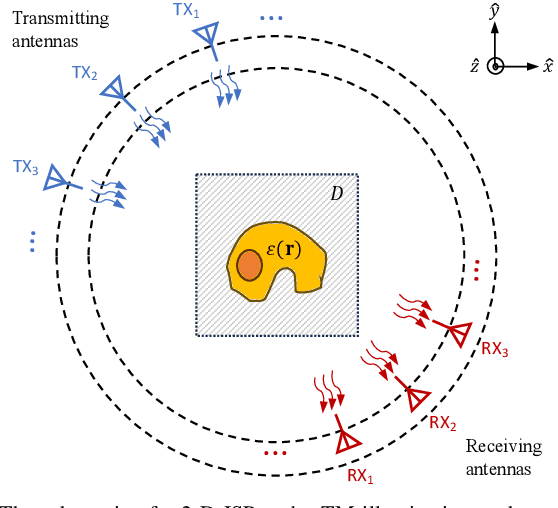

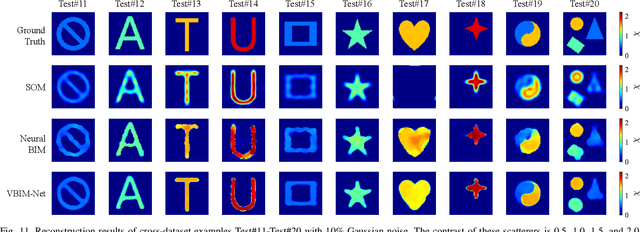

Abstract:Recently, studies have shown the potential of integrating field-type iterative methods with deep learning (DL) techniques in solving inverse scattering problems (ISPs). In this article, we propose a novel Variational Born Iterative Network, namely, VBIM-Net, to solve the full-wave ISPs with significantly improved flexibility and inversion quality. The proposed VBIM-Net emulates the alternating updates of the total electric field and the contrast in the variational Born iterative method (VBIM) by multiple layers of subnetworks. We embed the calculation of the contrast variation into each of the subnetworks, converting the scattered field residual into an approximate contrast variation and then enhancing it by a U-Net, thus avoiding the requirement of matched measurement dimension and grid resolution as in existing approaches. The total field and contrast of each layer's output is supervised in the loss function of VBIM-Net, which guarantees the physical interpretability of variables of the subnetworks. In addition, we design a training scheme with extra noise to enhance the model's stability. Extensive numerical results on synthetic and experimental data both verify the inversion quality, generalization ability, and robustness of the proposed VBIM-Net. This work may provide some new inspiration for the design of efficient field-type DL schemes.
 Add to Chrome
Add to Chrome Add to Firefox
Add to Firefox Add to Edge
Add to Edge